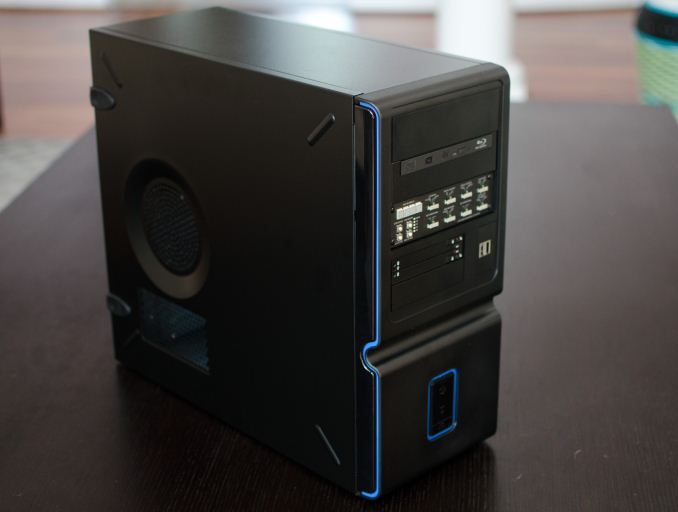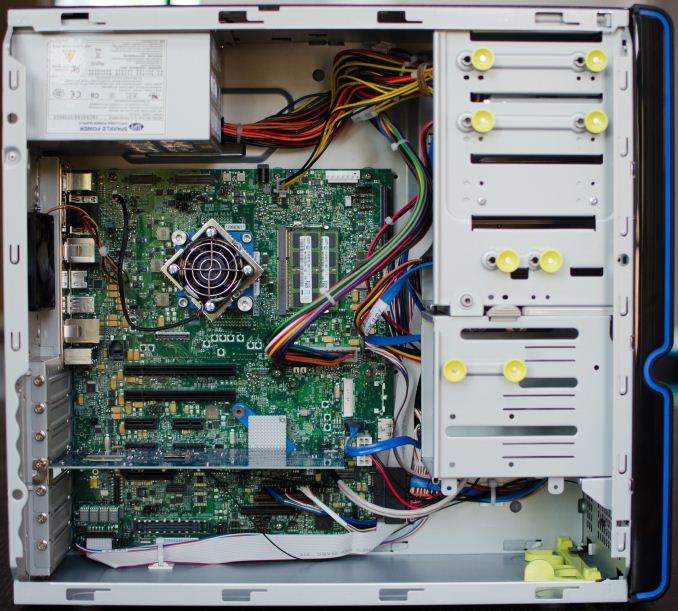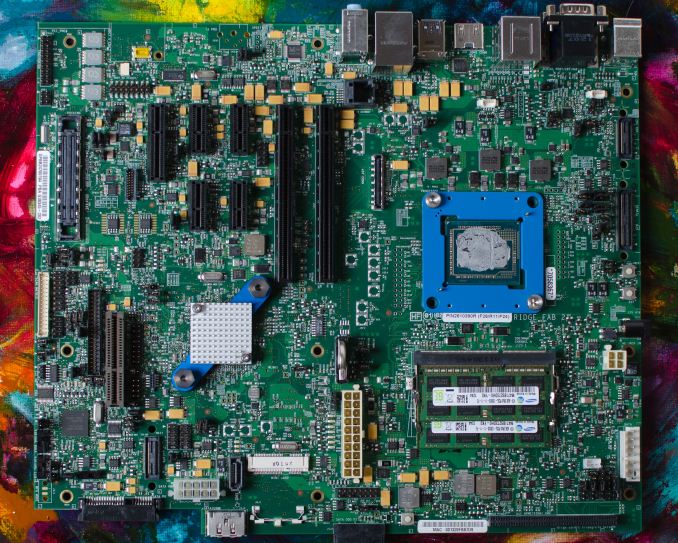Intel Iris Pro 5200 Graphics Review: Core i7-4950HQ Tested
by Anand Lal Shimpi on June 1, 2013 10:01 AM ESTThe Core i7-4950HQ Mobile CRB
At a high level, Iris Pro 5200 would seem to solve both problems that plagued Intel graphics in the past: a lack of GPU hardware and a lack of memory bandwidth. As a mostly mobile-focused design, and one whose launch partner isn’t keen on giving out early samples, it seemed almost impossible to evaluate Iris Pro in time for the Haswell launch. That was until a week ago when this showed up:
What may look like a funny mid-tower from a few years ago is actually home to one of Intel’s mobile Customer Reference Boards (CRB). Although the chassis is desktop-sized, everything inside is optimized for mobile. It’s just easier to build things larger, especially when it comes to testing and diagnosing problems.
The silicon on-board is a 47W Core i7-4950HQ, the lowest end launch SKU with Iris Pro 5200 graphics. The chassis is obviously overkill for a 47W part, but the performance we get with this machine should be representative of any i7-4950HQ system with a cooler capable of dissipating 47W.
If you read our Haswell CPU review you’ll know that Intel tried to be stingy with telling us die sizes and transistor counts for the bulk of the Haswell lineup, electing to only give us data on dual-core Haswell GT3 and quad-core Haswell GT2. Knowing that mobile parts ship without integrated heat spreaders, I went to work on pulling off the i7-4950HQ’s heatsink (after I finished testing, just in case).
With the heatsink off and thermal paste wiped off, I used my bargain basement calipers to get a rough idea of die area. This is what I came up with:
| Intel Haswell | |||||||||||||||||
| CPU Configuration | GPU Configuration | Die Size | Transistor Count | ||||||||||||||
| Haswell GT3e (QC) | Quad-Core | GT3e | 264mm2 + 84mm2 | ? | |||||||||||||
| Haswell GT2 (QC) | Quad-Core | GT2 | 177mm2 | 1.4B | |||||||||||||
| Haswell ULT GT3 | Dual-Core | GT3 | 181mm2 | 1.3B | |||||||||||||
The Crystalwell die measures 7mm x 12mm (84mm^2), while the quad-core Haswell + GT3 die is a whopping 264mm^2 (16.2mm x 16.3mm). Working backwards from the official data Intel provided (177mm^2 for quad-core GT2), I came up with an 87mm^2 adder for the extra hardware in Haswell GT3 vs. GT2. Doubling that 87mm^2 we get a rough idea of how big the full 40 EU Haswell GPU might be: 174mm^2. If my math is right, this means that in a quad-core Haswell GT3 die, around 65% of the die area is GPU. This is contrary to the ~33% in a quad-core Haswell GT2. I suspect a dual-core + GT3 design is at least half GPU.














177 Comments
View All Comments
HisDivineOrder - Saturday, June 1, 2013 - link
I see Razer making an Edge tablet with an Iris-based chip. In fact, it seems built for that idea more than anything else. That or a NUC HTPC run at 720p with no AA ever. You've got superior performance to any console out there right now and it's in a size smaller than an AppleTV.So yeah, the next Razer Edge should include this as an optional way to lower the cost of the whole system. I also think the next Surface Pro should use this. So high end x86-based laptops with Windows 8 Pro.
And NUC/BRIX systems that are so small they don't have room for discrete GPU's.
I imagine some thinner than makes sense ultrathins could also use this to great effect.
All that said, most systems people will be able to afford and use on a regular basis won't be using this chip. I think that's sad, but it's the way it will be until Intel stops trying to use Iris as a bonus for the high end users instead of trying to put discrete GPU's out of business by putting these on every chip they make so people start seeing it CAN do a decent job on its own within its specific limitations.
Right now, no one's going to see that, except those few fringe cases. Strictly speaking, while it might not have matched the 650m (or its successor), it did a decent job with the 640m and that's a lot better than any other IGP by Intel.
Spunjji - Tuesday, June 4, 2013 - link
You confused me here on these points:1) The NUC uses a 17W TDP chip and overheats. We're not going to have Iris in that form factor yet.
2) It would increase the cost of the Edge, not lower it. Same TDP problem too.
Otherwise I agree, this really needs to roll down lower in the food chain to have a serious impact. Hopefully they'll do that with Broadwell used by the GPU when the die area effectively becomes free thanks to the process switch.
whyso - Saturday, June 1, 2013 - link
So intel was right. Iris Pro pretty much matches a 650m at playable settings (30 fps +). Note that anandtech is being full of BullS**t here and comparing it to an OVERCLOCKED 650m from apple. Lets see, when intel made that 'equal to a 650m' claim it was talking about a standard 650m not an overclocked 650m running at 900/2500 (GDDR5) vs the normal 835/1000 (GDDR5 + boost at full, no boost = 735 mhz core). If you look at a standard clocked GDDR3 variant iris pro 5200 and the 650m are pretty much very similar (depending on the games) within around 10%. New Intel drivers should further shorten the gap (given that intel is quite good in compute).JarredWalton - Sunday, June 2, 2013 - link
http://www.anandtech.com/bench/Product/814For the games I tested, the rMBP15 isnt' that much faster in many titles. Iris isn't quite able to match GT 650M, but it's pretty close all things considered.
Spunjji - Tuesday, June 4, 2013 - link
I will believe this about new Intel drivers when I see them. I seriously, genuinely hope they surprise me, though.dbcoopernz - Saturday, June 1, 2013 - link
Are you going to test this system with madVR?Ryan Smith - Sunday, June 2, 2013 - link
We have Ganesh working to answer that question right now.dbcoopernz - Sunday, June 2, 2013 - link
Cool. :)JDG1980 - Saturday, June 1, 2013 - link
I would have liked to see some madVR tests. It seems to me that the particular architecture of this chip - lots of computing power, somewhat less memory bandwidth - would be very well suited to madVR's better processing options. It's been established that difficult features like Jinc scaling (the best quality) are limited by shader performance, not bandwidth.The price is far steeper than I would have expected, but once it inevitably drops a bit, I could see mini-ITX boards with this become a viable solution for high-end, passively-cooled HTPCs.
By the way, did they ever fix the 23.976 fps error that has been there since Clarkdale?
dbcoopernz - Saturday, June 1, 2013 - link
Missing Remote reports that 23.976 timing is much better.http://www.missingremote.com/review/intel-core-i7-...